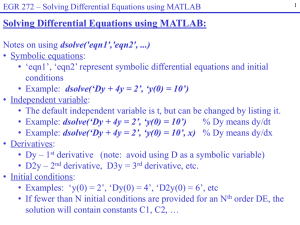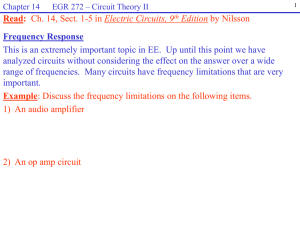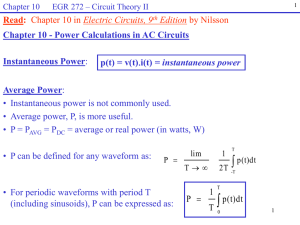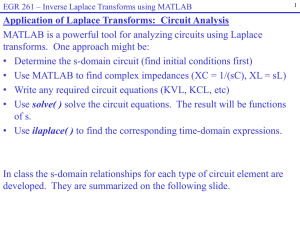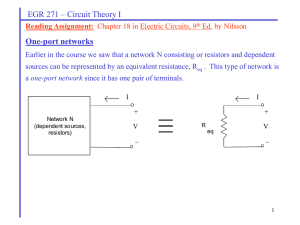Chapter 1
advertisement
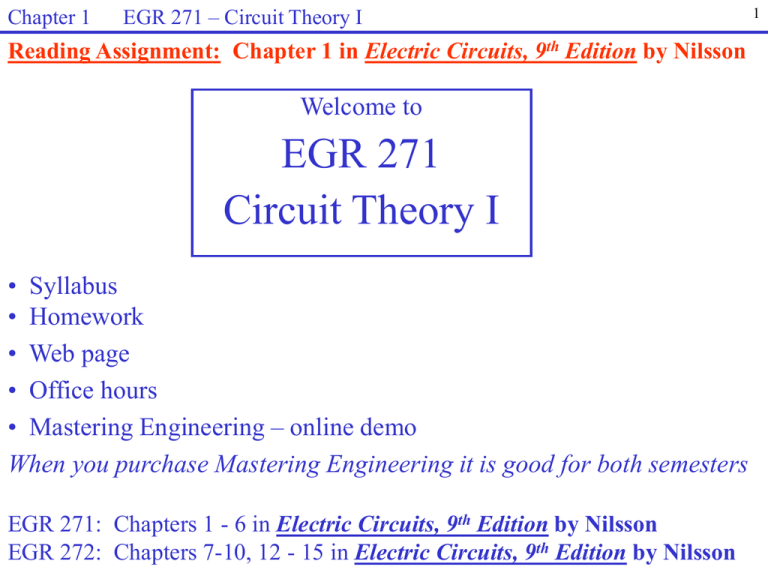
Chapter 1 EGR 271 – Circuit Theory I Reading Assignment: Chapter 1 in Electric Circuits, 9th Edition by Nilsson Welcome to EGR 271 Circuit Theory I • Syllabus • Homework • Web page • Office hours • Mastering Engineering – online demo When you purchase Mastering Engineering it is good for both semesters EGR 271: Chapters 1 - 6 in Electric Circuits, 9th Edition by Nilsson EGR 272: Chapters 7-10, 12 - 15 in Electric Circuits, 9th Edition by Nilsson 1 Chapter 1 EGR 271 – Circuit Theory I Changes to Electrical/Computer Engineering Courses at TCC Due to recent changes at ODU, TCC will make the following changes to the sequence of electrical/computer engineering courses: • EGR 260-261 will be replaced by EGR 271-272 • EGR 267 will no longer be offered • No changes to EGR 262 or EGR 270 The changes will be phased in as follows: • Fall 2013: First time EGR 271 will be offered Last time EGR 261 will be offered • Spring 2014: First time EGR 272 will be offered • See the chart on the following page for additional scheduling information 2 Chapter 1 EGR 271 – Circuit Theory I 3 Content differences between EGR 260-261 and EGR 271-272 The new course sequence at ODU actually is a return to the format that they used several years ago and is similar to the format used by many universities. How is EGR 271 different from EGR 260? • EGR 271 will be more manageable as it will cover less material (Ch. 1-6 in Nilsson instead of Ch. 1-8 covered in EGR 260). • MATLAB solutions for problems will be added to EGR 271. How is EGR 272 different from EGR 261? • EGR 272 will cover Ch. 7-10, 12-15 in Nilsson instead of Ch. 12-17 covered in EGR 261 + additional material from a second textbook in EGR 261). • AC circuit analysis will be added to EGR 272 (Ch. 9-10 in Nilsson). • MATLAB solutions for problems will be added to EGR 272. • Material on Fourier Series, Fourier transforms, convolution, and properties of linear signals and systems will be moved to a junior-level course at ODU. Chapter 1 EGR 271 – Circuit Theory I 4 Sequence of Electrical/Computer Engineering Courses at TCC EGR 271 (3 cr) Circuit Theory I ODU equiv: ECE 201 Offered: F, Sp, Su EGR 272 (3 cr) Circuit Theory II ODU equiv: ECE 202 Offered: F, Sp MTH 279 (4 cr) Differential Equations EGR 262 (2 cr) Fund. Circuits Lab ODU equiv: ECE 287 Offered: F, Sp, Su EGR 125 (4 cr) Into to Engineering Methods (C++) EGR 270 (4 cr) Fund. Of Computer EGR ODU equiv: ECE 241 Offered: F, Sp, Su Notes: 1. Classes available at the Virginia Beach Campus, the Chesapeake Campus, and the TriCities Center 2. EGR 271-272 transfers to Virginia Tech as ECE 2004 3. EGR 270 transfers to Virginia Tech as ECE 2504 4. EGR 262 does not transfer to Virginia Tech Chapter 1 EGR 271 – Circuit Theory I Chapter 1 - Circuit Variables Systems of Units • Most engineering disciplines have to routinely deal with two systems of units: US units and SI units • Electrical engineering uses SI units almost exclusively Example: List various units used in electrical engineering courses 5 Chapter 1 EGR 271 – Circuit Theory I 6 SI System • Recall that the SI system is a decimal system that uses prefixes as multipliers. • Some common SI prefixes are listed below: SI Prefixes Multiplier Prefix name Symbol 10+12 tera T +9 10 giga G 10+6 mega M 10+3 kilo k 10-3 milli m 10-6 micro -9 10 nano n 10-12 pico p 10-15 femto f Example: Ohm’s Law (V = IR) will be introduced in Chapter 2 where: V = voltage measured in volts, V I = current measured in amperes, A R = resistance measured in ohms, and 1V = (1A)(1 ) A) if I = 50.0 nA and R = 40.0 k , calculate V B) if R = 10.0 k and V = 3.75 mV, calculate I Chapter 1 EGR 271 – Circuit Theory I 7 SI System • The SI system is built on a system of 7 base units. • 4 of the 7 base units are shown below (the 4 that mainly affect this course) • Other units (derived units) are built on these base units. SI Base Units Quantity Length Mass Time Electric current Name meter kilogram second ampere Symbol m kg s A The first three base units listed above are familiar and will not be defined here. Electric current, along with some derived units, are perhaps not familiar and are defined in Chapter 1. Specifically, definitions for the following five important quantities will be provided since these are key quantities in this course. Charge Current Voltage Power Energy EGR 271 – Circuit Theory I Chapter 1 8 Charge Charge is a difficult quantity to define. One well-known circuits text defines charge as “the quantity of electricity responsible for electric phenomena.” This is a little vague. We will define charge as follows: Charge - an electrical property possessed by some materials that can result in forces of electrical attraction and repulsion. These forces are somewhat similar to gravitational forces. Charge is represented by the symbol q, Q, or q(t) and has units of coulombs, C. Gravitational Force Fg Electric Force due to Charge Fe Fg m1 m2 Q1 Q2 R R Newton’s Law of Gravitation: Fg Fe K g m1 m 2 R2 Coulomb’s Law: Fe K e Q1 Q 2 R2 Chapter 1 EGR 271 – Circuit Theory I Charge on an electron = -1.602 x 10-19 C Charge on a proton = +1.602 x 10-19 C Charge on a neutron = 0 Total charge on an atom = 0 Number of electrons needed to form 1C of charge = 6.24 x 10+18 The direction of the force of attraction/repulsion between charged particles depends on the relative polarities of the charges. In particular, • Opposite charges attract • Like charges repel Illustration: 9 Chapter 1 EGR 271 – Circuit Theory I 10 Current – the rate of change of charge with respect to time i(t) dq(t) dt in units of coulombs Amperes, A (So 1A = 1 C/s) second Illustration: Current can be thought of as the amount of charge flowing through a conductor (such as a wire) that crosses some plane over a specified period of time. I positive charge negative charge Direction of current: There are two conventions for describing the direction of the current: 1) electron flow 2) conventional current flow Chapter 1 EGR 271 – Circuit Theory I 11 Example: 25 billion electrons pass a given point in a conductor in 3 s. Determine the current I. Key relationships: dq(t) i(t) dt t Example: q(t) = 5e-6t mC. q(t) i(t)dt - t i(t)dt 0 Determine the current i(t). q(0) EGR 271 – Circuit Theory I Chapter 1 Example: Sketch i(t) for q(t) shown below. q(t) [C] 12 0 3 6 9 t [s] 12 Chapter 1 EGR 271 – Circuit Theory I Example: Sketch q(t) for i(t) shown below. i(t) [A] 16 t [s] 0 2 4 13 Chapter 1 EGR 271 – Circuit Theory I Upper case vs. lower case: In some areas of engineering, upper case and lower case variables are used for different quantities. In this course, however, there is generally no distinction. Example: List various quantities in upper and lower case form. 14 Chapter 1 EGR 271 – Circuit Theory I 15 Voltage – change in energy with respect to charge dW v(t) dq joules in units of volts, V coulomb (so 1V = 1J/C ) • The definition above is not generally familiar to the layman • voltage is also referred to as potential difference • voltage should always be expressed with a polarity (+ and - terminals) Polarity: voltage should always be expressed with a polarity (+ and - terminals) + 12V -12V - + Two equivalent representations of the voltage across a circuit element 12V Unclear Chapter 1 EGR 271 – Circuit Theory I 16 Illustration: If 1V = 1 J/C, then 1V of potential difference exists across an element if 1J of energy is expended in passing 1C of charge though the element as illustrated below: electrons enter the device at a higher energy level 1C + 1V Element 1J of energy is used (stored or given off as heat or light) _ 1C electrons leave the device at a lower energy level Chapter 1 EGR 271 – Circuit Theory I 17 Voltage is sometimes referred to as an “electrical pressure” which forces charge through a circuit. Water system analogy: Sometimes an analogy is made between an electric circuit and a water system. This may help to give a more intuitive feel to terms like charge, current, and voltage. Electrical System Water System Chapter 1 EGR 271 – Circuit Theory I 18 Passive and Active Devices Passive device – a device that dissipates (uses) energy. The energy is given off as heat or light. Examples of passive devices: resistors, inductors, and capacitors (to be introduced later). Practical items like filaments in bulbs, burners on a stove, etc., are essentially resistors so they are also passive devices. The burner on your stove can only use energy - it can’t produce energy on its own. Passive sign convention – current is shown entering the positive terminal. Therefore, if the current direction is known, then the voltage polarity is known, and vice versa. + I Passive Device V _ Passive Device The voltage polarity is known from the current direction or the current direction is known from the voltage polarity Chapter 1 EGR 271 – Circuit Theory I 19 Passive Sign Convention and Ohm’s Law Ohm’s Law will be introduced in Chapter 2, but here it will be used briefly to make a point about passive sign convention. Ohm’s Law: V = IR (voltage = current x resistance) This law describes how voltage and current are related for a resistor. Since a resistor is a passive device, this formula requires that passive sign convention be used. Example: Calculate the voltage, V, across the resistor shown below. _ I = 2A V R = 10 + Chapter 1 EGR 271 – Circuit Theory I 20 Active device – a device that is capable of delivering (supplying) energy, but might use energy, such as when a battery is being charged. Examples of active devices: batteries, voltage sources, and current sources (to be introduced later) Active sign convention – current is shown leaving the positive terminal. Therefore, if the current direction is known, then the voltage polarity is known, and vice versa. Examples: Show examples of active-sign convention used with batteries and voltage sources Chapter 1 EGR 271 – Circuit Theory I 21 Power – the rate of change of energy with respect to time power p(t) dW joules in watts, W dt second (so 1 W = 1 J/s) also p(t) dW dW dq v i in (volts)(amperes) watts, W (so 1 W = 1 V·A) dt dq dt Notes: • If voltage and current are shown using passive sign convention then p = vi calculates power absorbed (or used or dissipated) • If voltage and current are shown using active sign convention then p = vi calculates power delivered (or generated or supplied) • Power delivered = -(Power absorbed) for a given device – For example, if a device is absorbing 20W then it is delivering -20W. • Whenever power is calculated, it should be made clear whether it is absorbed or delivered Chapter 1 EGR 271 – Circuit Theory I Example: Find the power in each case shown below. Case 1: + 15 V + 15 V _ 2A Case 2: _ -2A Case 3: _ 15 V + 2A Case 4: _ -2A 15 V + 22 Chapter 1 EGR 271 – Circuit Theory I 23 Power check: For any circuit the following relationship exists: Pdel = Pabs Example: Shown below is an illustration of using one car battery to “jump start” another car battery. Perform a “power check.” (Calculate the power for each battery.) 10A + 12V Good car battery - 12V + Weak car battery Chapter 1 EGR 271 – Circuit Theory I Example The numerical values for the currents and voltages in the circuit shown are given in the table below. Find the total power developed in the circuit. Show that Pdel = Pabs. 24 Chapter 1 EGR 271 – Circuit Theory I Energy: W or w(t) = energy 25 (in joules, where 1J = 1Ws ) t dW p(t) dt w(t) so p(t)dt - t or w(t) p(t)dt w(0) 0 Example: Given p(t) below, find the energy at time t = 3 seconds p(t) 50W t [s] 0 2 4 Chapter 1 EGR 271 – Circuit Theory I 26 Example: If i(t) is the current entering the device shown below, sketch p(t) and w(t). i(t) i(t) + 4A 4 0 2 -4A 0 6V 6 t [s] - Chapter 1 EGR 271 – Circuit Theory I Energy Cost Virginia Power charges for the amount of energy that is used each month (power is the rate at which the energy is used). The unit of energy used on power bills is the kilowatt-hour, kWh. 1 kWh = (1000W)(3600 s) = 3600000 Ws = 3.6 MJ A typical rate used for energy costs might be 8¢/ kWh (discuss) If energy is used linearly, then dW W p(t) so W P(t) dt t Typical power rates for appliances: Appliance Air conditioner Blow dryer Clock Dishwasher Electric Dryer Microwave Oven Television Electric Water Heater Power Rating (W) 860 1300 2 1200 4800 800 150 2500 27 Chapter 1 EGR 271 – Circuit Theory I Example: Calculate the monthly cost to keep a porch light on each night. 28


